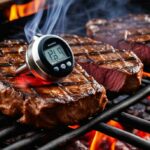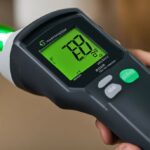Last Updated on 4 months by Francis
Are you in need of a reliable temperature measurement device for high-temperature applications? Look no further than the infrared sensor gun, also known as an IR thermometer. These powerful devices are designed to accurately measure temperatures in extreme conditions, making them essential tools for technicians in various industries.
IR thermometers utilize a temperature sensor to measure heat as infrared radiation. With their advanced technology, they can handle high temperatures, reaching up to 4000°F (2200°C). This impressive range allows them to tackle even the most extreme temperature measurement tasks.
Whether you work in electrical, HVAC, or industrial maintenance, an IR thermometer can provide the accurate temperature readings you need. Its non-contact measurement capability ensures safety and efficiency in your temperature monitoring processes.
Contents
Key Takeaways:
- The infrared sensor gun, or IR thermometer, is a temperature measurement device used in various industries.
- It uses a temperature sensor to measure heat as infrared radiation.
- IR thermometers have a high-temperature range of up to 4000°F (2200°C).
- These devices are non-contact and ensure safety and efficiency in temperature monitoring processes.
- IR thermometers are essential tools for technicians in electrical, HVAC, and industrial maintenance.
How Do IR Thermometers Work?

IR thermometers, also known as infrared thermometers or IR guns, are highly efficient temperature measurement devices that utilize a temperature sensor to detect infrared radiation. This innovative technology allows for non-contact temperature measurement, making it a popular choice in various industries.
So, how do IR thermometers work? Let’s dive into the details:
- Design: IR thermometers are typically designed in the shape of a gun, featuring a comfortable grip, a trigger for activation, a laser pointer for targeting, and a temperature display with control buttons. This ergonomic design ensures ease of use and accurate readings.
- Measurement: When the trigger is clicked, the IR thermometer activates the laser pointer to mark the targeted spot. It then measures the average temperature of that spot using the temperature sensor, which detects the infrared radiation emitted by the object.
- Accuracy: The accuracy of an IR thermometer is determined by its distance-to-spot ratio, which refers to the ratio of the distance between the thermometer and the object to the size of the spot being measured. High-quality IR thermometers can have ratios as high as 50:1, allowing for precise temperature measurements even at a distance.
“IR thermometers offer a convenient and efficient way to measure temperature without physical contact, making them essential tools in industries such as electrical, HVAC, and industrial maintenance.”
An IR Thermometer in action, used by a technician for non-contact temperature measurement.
IR thermometers are highly accurate, providing quick temperature readings without the need for direct contact with the object. This non-contact feature ensures safety, especially when dealing with hazardous or hard-to-reach areas.
With their wide range of applications and ease of use, IR thermometers are relied upon by professionals in various fields for temperature monitoring and analysis purposes.
Advantages of IR Thermometers:
- Non-contact temperature measurement for increased safety
- Quick and efficient temperature readings
- High accuracy, even from a distance
- Portable and easy to use
By harnessing the power of temperature sensors and infrared radiation detection, IR thermometers offer a reliable and convenient solution for temperature measurement in countless industries and applications.
Applications of IR Thermometers

IR thermometers, with their advanced temperature sensing technology, are indispensable tools in various industries for temperature monitoring and control. Let’s explore some key applications of these versatile devices:
1. Firefighting and Hot Spot Detection
Firefighters use IR thermometers to identify hot spots in buildings, electrical panels, and equipment during firefighting operations. The non-contact nature of IR thermometers allows firefighters to assess temperatures from a safe distance, ensuring their well-being and effective extinguishing of fires.
2. Mechanical and Electrical Equipment Monitoring
Technicians rely on IR thermometers to monitor the temperature of mechanical and electrical equipment, such as motors, bearings, circuitry, and transformers. By regularly checking temperatures, they can detect anomalies, identify potential issues, and perform preventive maintenance, minimizing downtime and costly repairs.
3. HVAC Systems and Energy Efficiency
IR thermometers help HVAC technicians optimize the efficiency of heating, ventilation, and air conditioning systems. By measuring temperatures in ducts, vents, and HVAC components, technicians can ensure proper heat transfer, identify airflow issues, and diagnose faulty components, leading to energy savings and improved comfort for occupants.
4. Cooking and Food Safety
In the food industry, IR thermometers are used to monitor cooking, holding, and storage temperatures of food products. By checking temperature variations within ovens, grills, refrigerators, and serving stations, professionals can adhere to food safety guidelines, prevent foodborne illnesses, and maintain quality standards.
5. Manufacturing Processes
“Accurate temperature monitoring in manufacturing processes is crucial for ensuring product quality and consistency.”
In manufacturing, IR thermometers play a vital role in temperature-sensitive processes like heating, cooling, and curing. By monitoring material temperatures during production, technicians can optimize process parameters, prevent overheating or underheating, and maintain product quality and consistency.
6. Energy Audits
During energy audits, IR thermometers are used to assess insulation, detect air leaks, and evaluate the efficiency of windows, doors, and HVAC systems. By identifying energy losses and areas of improvement, auditors can recommend energy-saving measures, reducing energy consumption and lowering utility costs.
From firefighting to manufacturing, IR thermometers offer precise and efficient temperature sensing technology for diverse applications. With their ability to provide non-contact temperature measurements, these devices enhance safety, improve process control, and save time across multiple industries.
Choosing the Right IR Thermometer
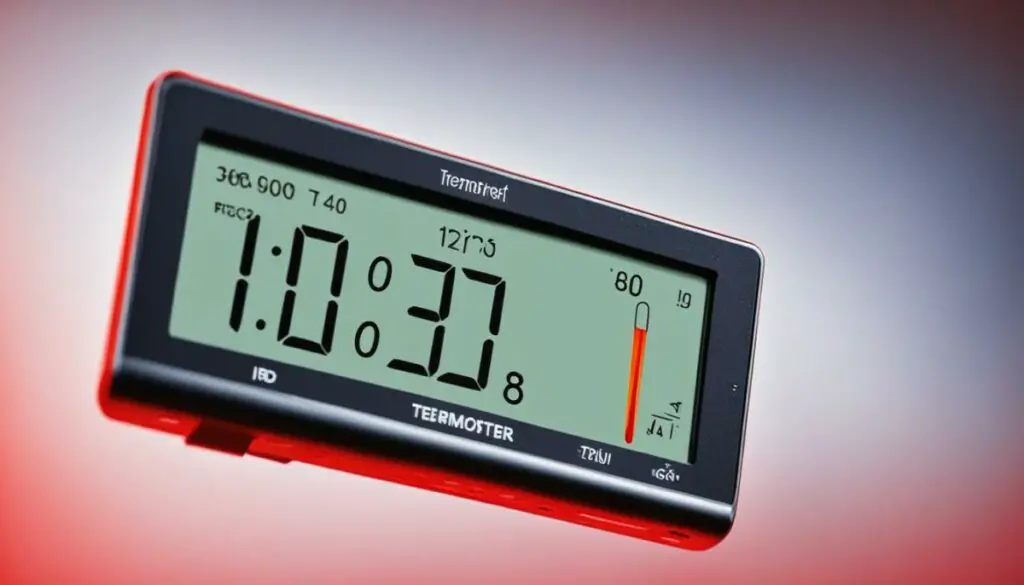
When it comes to selecting an IR thermometer, there are several important factors to consider. The temperature range, distance-to-spot ratio, and additional features can greatly impact the accuracy and functionality of the thermometer. Let’s explore these factors in detail to help you make an informed decision.
Temperature Range
The temperature range refers to the minimum and maximum temperatures that an IR thermometer can measure. Different models offer varying ranges, so it’s essential to choose one that aligns with your specific temperature measurement needs. Whether you are working in a low-temperature environment or dealing with extremely high temperatures, ensure that the thermometer can accurately measure within the desired range.
Distance-to-Spot Ratio
The distance-to-spot ratio is a critical consideration, especially if you need to measure temperature from a distance. This ratio indicates the size of the measurement area in relation to the distance from the target object. A higher ratio allows you to measure from a distance while maintaining accuracy. For example, an IR thermometer with a 20:1 ratio means you can measure the temperature of a 1-inch spot from 20 inches away. Prioritize a higher ratio if you frequently need to measure temperature from afar.
Additional Features
Beyond the fundamental temperature range and distance-to-spot ratio, consider any additional features that might enhance your experience with the IR thermometer. Some models offer customizable emissivity settings for different surface types, allowing for more accurate measurements. Others may have features like video capture or waterproof protection, which can be beneficial depending on your specific needs and working conditions. Take the time to assess which additional features will be valuable for your temperature measurement tasks.
By carefully considering the temperature range, distance-to-spot ratio, and additional features of an IR thermometer, you can select the right instrument for your needs. Remember that accuracy and reliability are key when it comes to temperature measurement, so choose a thermometer that aligns with your specific requirements.
| Factors | Considerations |
|---|---|
| Temperature Range | Choose a thermometer that covers the desired temperature range. |
| Distance-to-Spot Ratio | Select a thermometer with a higher ratio if you need to measure from a distance. |
| Additional Features | Evaluate the additional features offered and determine their relevance to your specific needs. |
Having the right IR thermometer will allow you to measure temperatures accurately and efficiently, promoting safety and productivity in various industries.
Benefits of Non-Contact and Accurate Temperature Measurement
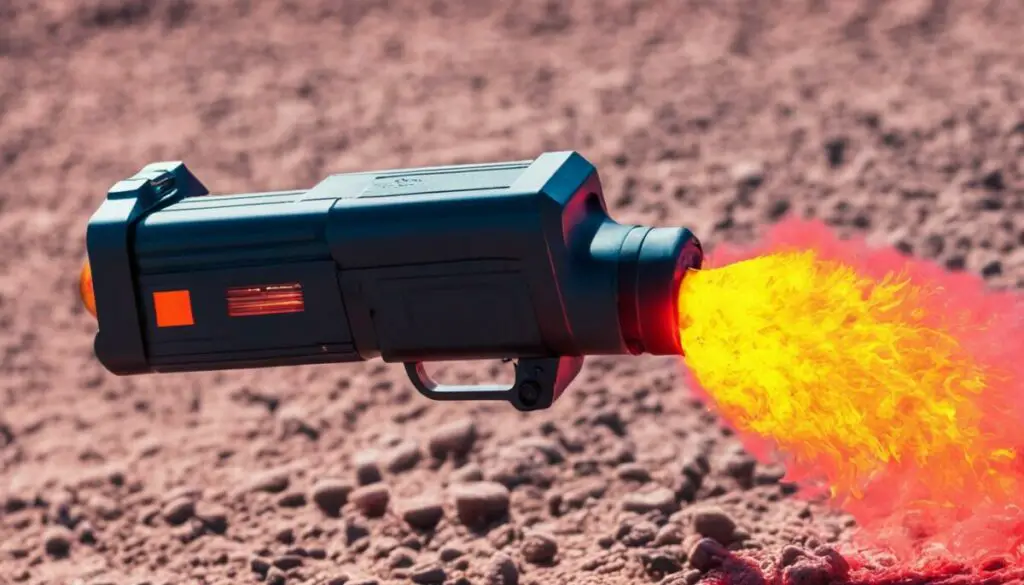
Non-contact temperature measurement is one of the key advantages offered by IR thermometers, making them invaluable tools in various industries. By eliminating the need for thermal contact with the target object, these devices provide a range of benefits that enhance efficiency, safety, and productivity.
Continuous process measurements are made possible through non-contact temperature measurement. Technicians and professionals can monitor temperatures in real-time without interrupting the workflow, ensuring that critical equipment remains operational within the desired temperature range.
Elevating safety levels by avoiding contact with dangerous objects is another advantage of non-contact temperature measurement. This feature allows technicians to accurately measure temperatures in hazardous or hard-to-reach areas, reducing the risk of injuries or accidents.
Accurate temperature measurement is also a significant benefit provided by IR thermometers. These devices offer precise readings across a range of surfaces, enabling professionals to obtain reliable and consistent temperature data. The accuracy of these measurements contributes to maintaining product quality, ensuring optimal performance, and identifying potential issues promptly.
IR thermometers are designed to be user-friendly, allowing professionals from various industries to easily operate them. With straightforward controls and clear temperature displays, these devices enable quick and hassle-free temperature measurements, saving time and streamlining workflows.
Benefits of Non-Contact and Accurate Temperature Measurement:
- Continuous process measurements without interrupting workflow
- Enhanced safety by avoiding contact with dangerous objects
- Precise temperature measurements for reliable data
- User-friendly operation for quick and hassle-free measurements
Factors Affecting IR Thermometer Accuracy
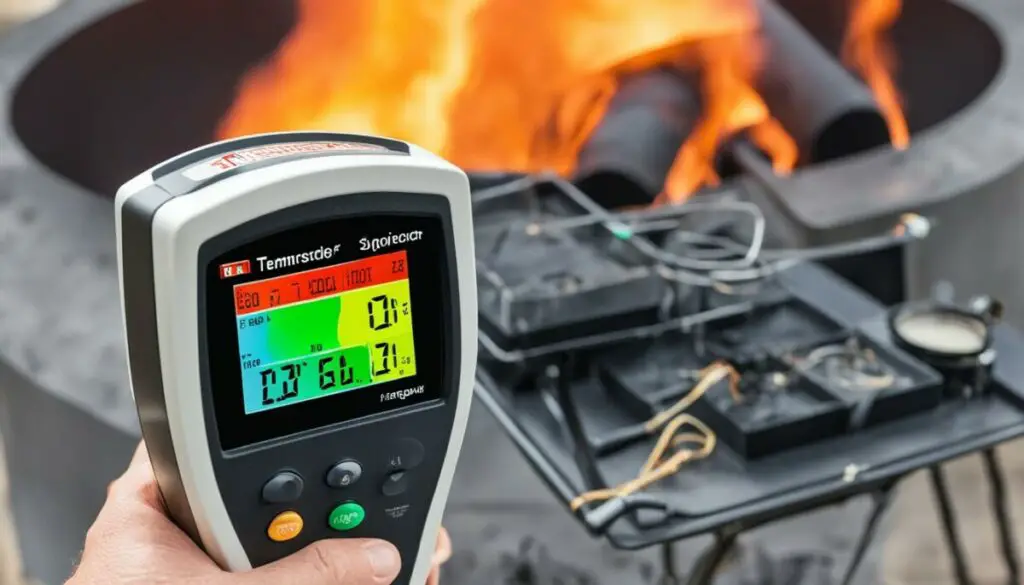
The accuracy of an IR thermometer can be influenced by several factors that need consideration for precise temperature measurements. Two key factors that directly impact accuracy are emissivity and the distance-to-spot ratio.
Emissivity
Emissivity refers to the ability of an object to emit infrared energy. Different surfaces have varying emissivity values, which means they emit and reflect infrared radiation differently. To obtain accurate readings with an IR thermometer, it is crucial to adjust the device’s emissivity setting based on the surface being measured.
Distance-to-Spot Ratio
The distance-to-spot ratio is another important factor affecting the accuracy of an IR thermometer. This ratio determines the size of the spot measured at a given distance. Larger distances result in larger spot sizes. Considering the distance-to-spot ratio is essential as larger spot sizes can include cooler elements and lead to inaccurate temperature readings.
By understanding the impact of emissivity and the distance-to-spot ratio, technicians can ensure accurate temperature measurements using IR thermometers.
Tips for Using IR Thermometers Effectively
To make the most of your IR thermometer and ensure accurate temperature measurements, follow these helpful tips:
1. Target Object Size:
Ensure that the target object is larger than the spot size being measured. If the object is smaller than the measurement area, the reading may include surrounding cooler elements, leading to inaccurate results.
2. Distance-to-Spot Ratio:
Consider the distance-to-spot ratio of your thermometer. This ratio determines the size of the measurement area relative to the distance from the object. Choosing a thermometer with a high ratio allows you to measure from a safe distance without compromising accuracy.
3. Emissivity Adjustment:
Understand the emissivity of different surfaces and adjust the thermometer accordingly. Emissivity refers to the object’s ability to emit infrared energy. Most IR thermometers have adjustable emissivity settings to provide accurate readings across various materials.
4. Calibration and Maintenance:
Regularly calibrate and maintain your IR thermometer to ensure its accuracy and reliability. Calibration involves comparing the thermometer’s readings against a known temperature source and making necessary adjustments. Cleaning the lens and keeping it free from dirt or debris also contributes to accurate measurements.
5. Consider Ambient Conditions:
Take note of any ambient conditions that may affect IR thermometer readings. Factors such as smoke, dust, or steam can interfere with the accuracy of the measurements. Ensure a clear line of sight between the thermometer and the target object for optimal results.
Tip: Record the ambient temperature and other relevant details when measuring temperatures to provide additional context for future reference or troubleshooting.
Popular Brands and Models of IR Thermometers
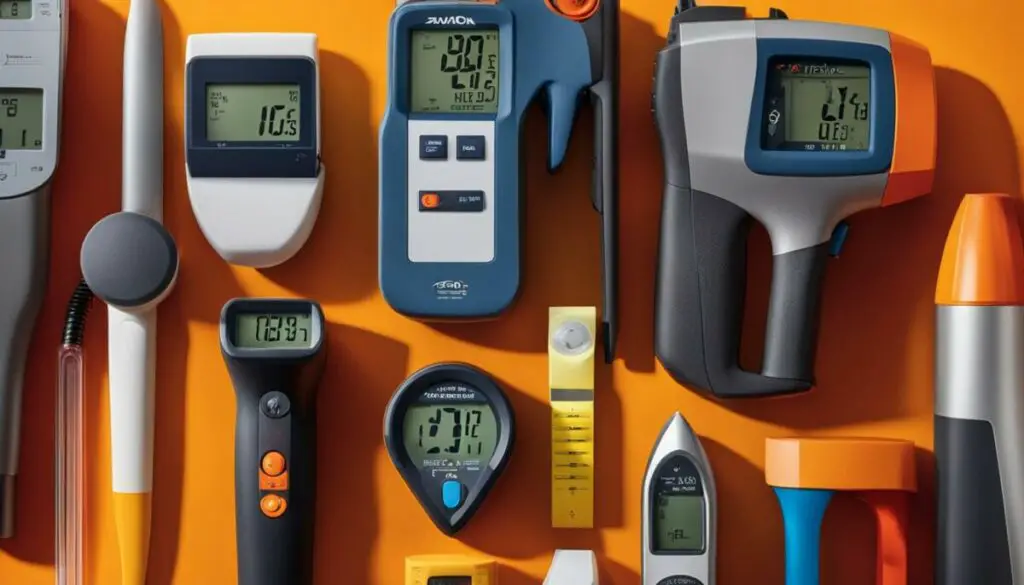
When it comes to high-quality IR thermometers, several popular brands have established themselves as reliable providers of accurate temperature measurement devices. These brands offer a range of models with different features and capabilities, catering to diverse industry needs.
FLIR: FLIR is a renowned brand known for its expertise in infrared technology. Their IR thermometer models are highly regarded for their accuracy and reliability. One popular model from FLIR is the TG165, which offers a wide temperature range and a rugged design, making it suitable for various applications.
Extech: Extech is another well-known brand in the field of IR thermometers. Their models are praised for their affordability and ease of use. Among their top models is the IR267, which provides accurate temperature readings and features a laser pointer for precise targeting.
Fluke: Fluke is a trusted brand known for its high-performance instruments. Their IR thermometers are no exception, offering superior accuracy and durability. The Fluke 62 Max is a popular choice, with its rugged design, wide temperature range, and precise measurements.
Klein Tools: Klein Tools is a respected brand in the industry, known for its quality hand tools. Their IR thermometers are designed with reliability and user-friendliness in mind. The IR07 is a top model that offers accurate temperature measurements and a wide temperature range.
These popular brands and models have earned their reputation through years of delivering exceptional performance and meeting the temperature measurement needs of professionals across various industries.
“The accuracy and reliability of these popular brands make them the go-to choice for professionals in need of precise temperature measurements.”
Here is an image showcasing some of the popular brands and models of IR thermometers:
| Brand | Model | Temperature Range | Distance-to-Spot Ratio | Additional Functions |
|---|---|---|---|---|
| FLIR | TG165 | -25°F to 600°F (-32°C to 315°C) | 24:1 | Rugged Design |
| Extech | IR267 | -58°F to 1022°F (-50°C to 550°C) | 8:1 | Laser Pointer |
| Fluke | 62 Max | -22°F to 932°F (-30°C to 500°C) | 10:1 | Rugged Design, Min/Max/Avg Readings |
| Klein Tools | IR07 | -4°F to 482°F (-20°C to 250°C) | 10:1 | Backlit Display, Dual-Laser Targeting |
Future Trends in IR Temperature Measurement
The field of IR temperature measurement is constantly evolving with advancements in technology and the demand for increased accuracy. The future holds exciting prospects for the development of IR thermometers, paving the way for more precise temperature measurements and improved functionality.
One of the areas where significant progress is expected is sensor technology. With ongoing research and development, sensors in IR thermometers will see improvements in resolution and response times. This enhancement will enable more precise readings, allowing technicians and professionals to obtain accurate temperature measurements with greater confidence and efficiency.
Another key aspect of future trends is the integration of smart technology into IR thermometers. These advancements will enable better connectivity and data analysis capabilities, facilitating the seamless transfer and interpretation of temperature data. With improved connectivity, technicians can easily monitor and analyze temperature readings remotely, enhancing their troubleshooting and decision-making processes.
Furthermore, the incorporation of artificial intelligence (AI) and machine learning algorithms has the potential to revolutionize the capabilities of IR thermometers. AI algorithms can analyze large datasets and identify patterns that may go unnoticed by the human eye. By leveraging AI technology, IR thermometers may be able to provide more detailed insights and predictions regarding temperature trends and potential issues, further optimizing temperature measurement processes.
Key Advancements in Future IR Temperature Measurement:
- Enhanced sensor technology for higher resolution and faster response times
- Integration of smart technology for improved connectivity and data analysis
- Potential use of artificial intelligence and machine learning algorithms for advanced data interpretation
As the future unfolds, the evolution of IR temperature measurement technology will continue to drive advancements in various industries. Professionals and technicians can look forward to more accurate and efficient temperature measurements, enabling them to make informed decisions and maintain optimal working conditions in their respective fields.
Advantages and Limitations of IR Thermometers
IR thermometers, also known as infrared thermometers, offer several advantages that make them valuable tools for temperature measurement in various industries.
- Non-contact temperature measurement: One of the key advantages of IR thermometers is that they allow for non-contact temperature measurement. This means that measurements can be taken without physically touching the object or surface, making them ideal for delicate or hazardous environments.
- Quick and easy readings: IR thermometers provide rapid temperature readings, allowing technicians to quickly assess the temperature of equipment or objects. The ease of use and instant results make them efficient and time-saving tools.
- Versatile applications: IR thermometers have a wide range of applications across various industries. They can be used in electrical maintenance, HVAC systems, automotive diagnostics, food processing, and more. Their versatility makes them suitable for different temperature measurement needs.
- Portable and user-friendly: IR thermometers are compact and portable, making them easy to carry and use in different settings. They are designed with intuitive controls and clear temperature displays, enabling technicians to operate them effectively.
- Accurate temperature measurements: Despite their non-contact nature, IR thermometers provide accurate temperature measurements when used correctly. This accuracy is crucial in ensuring the reliability of temperature readings for critical operations.
However, it is important to acknowledge the limitations of IR thermometers:
- Cannot measure through transparent surfaces: IR thermometers rely on detecting infrared radiation, so they cannot measure temperatures through transparent materials such as glass or plastic.
- Require a clear line of sight: For accurate measurements, IR thermometers require a clear line of sight between the thermometer and the target object. Obstructions in the line of sight, such as barriers or reflections, may affect the accuracy of the readings.
- Affected by external factors: Factors such as smoke, dust, or steam can interfere with IR thermometers and affect the accuracy of temperature measurements. Technicians should consider these external factors and mitigate their impact when using IR thermometers.
Understanding the advantages and limitations of IR thermometers is crucial in making informed decisions about their usage and choosing the appropriate temperature measurement device for specific needs.
Conclusion
Infrared sensor guns, also known as IR thermometers, are essential tools for accurately measuring high temperatures in various industries. Their non-contact measurement capabilities make them safe and convenient to use. With a wide range of temperature measurements and portability, professionals can rely on IR thermometers to obtain accurate results in a quick and efficient manner.
By considering factors such as temperature range, distance-to-spot ratio, and surface emissivity, users can select the right IR thermometer for their specific needs. Whether it’s monitoring equipment in the electrical or HVAC industry, identifying hot spots as a firefighter, or controlling temperatures in manufacturing processes, IR thermometers provide reliable temperature sensing technology.
As technology continues to advance, the future of IR temperature measurement looks promising. There will be improvements in accuracy and increased connectivity, allowing for better data analysis and integration with other smart systems. Infrared sensor guns will continue to be vital tools for professionals who require precise temperature measurements in high-temperature environments.
FAQ
Can an infrared sensor gun measure high temperatures?
Yes, infrared sensor guns, also known as IR thermometers, can measure high temperatures. They have a range of temperature measurements, with some models capable of measuring temperatures up to 4000°F (2200°C).
How do IR thermometers work?
IR thermometers work by using a temperature sensor to measure heat as infrared radiation. They detect the average temperature of a small spot by measuring the infrared radiation emitted by the object.
What are the applications of IR thermometers?
IR thermometers are used in various industries for temperature monitoring. They are used by firefighters to check for hot spots, by technicians to monitor mechanical and electrical equipment, and by professionals to calibrate and control heater or oven temperature. They are also used in manufacturing processes for monitoring materials during heating or cooling.
How do I choose the right IR thermometer?
When choosing an IR thermometer, consider the temperature range it covers and the distance-to-spot ratio. Select a thermometer with a range that matches your specific temperature measurement needs, and choose a model with a higher distance-to-spot ratio if you need to measure from a distance.
What are the benefits of using an IR thermometer?
IR thermometers offer non-contact temperature measurements, quick readings, and versatility in various applications. They are portable, easy to use, and provide accurate results. They also improve safety by avoiding thermal contact with dangerous objects and enhance production efficiency.
What factors can affect the accuracy of an IR thermometer?
The accuracy of an IR thermometer can be affected by factors such as the object’s emissivity and the distance-to-spot ratio. It is important to adjust the thermometer’s emissivity setting according to the surface type being measured and consider the distance-to-spot ratio for accurate readings.
What are some tips for using IR thermometers effectively?
To use an IR thermometer effectively, ensure that the target object is larger than the spot size being measured, consider the distance-to-spot ratio, and use the thermometer at a safe distance. Understand the emissivity of different surfaces and adjust the thermometer accordingly. Regular calibration and maintenance also improve effectiveness.
What are some popular brands and models of IR thermometers?
Some popular brands of IR thermometers include FLIR, Extech, Fluke, and Klein Tools. Examples of popular models include the FLIR TG165, Extech IR267, Fluke 62 Max, and Klein Tools IR07. These brands and models are known for their accuracy and reliability in temperature measurement.
What can we expect in the future of IR temperature measurement?
The future of IR temperature measurement is expected to bring advancements in technology and increased accuracy. Improvements in sensor technology, including higher resolution and faster response times, will enhance the precision of temperature measurements. Advancements in smart technology will allow for better connectivity and data analysis, and the incorporation of artificial intelligence and machine learning algorithms may further improve the capabilities of IR thermometers.
What are the advantages and limitations of IR thermometers?
The advantages of IR thermometers include non-contact temperature measurement, quick readings, and versatility in various applications. They are portable, easy to use, and provide accurate results. However, they have limitations as well. They cannot measure through transparent surfaces, require a clear line of sight, and may be affected by factors like smoke, dust, or steam.
What are the main uses of an infrared sensor gun?
Infrared sensor guns, or IR thermometers, are used in various industries to measure high temperatures. They are essential tools for technicians who need to check the temperature of equipment in electrical, HVAC, and industrial maintenance settings, among others. IR thermometers provide non-contact temperature measurements, ensuring safety and efficiency in temperature monitoring processes.



